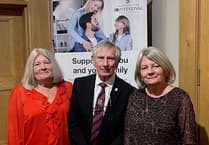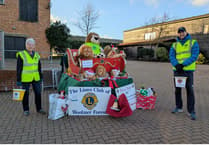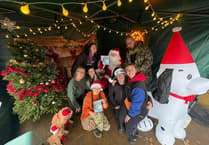Joan was born in Greenwich then moved to Wickham Road, Brockley, in south-east London.
She was the daughter of WAE (Bill) Farmer, an early photographer, and Winifred Shepherd, who set up and ran a Christian Mission together – values that inculcated in her from an early age and stayed with her through life.
Joan went to Mary Dachelor Girls’ School in Camberwell. She was a scholarship girl and by all accounts one the brightest in her year. Responsibility was thrust on her at an early age when Joan was evacuated with her younger sister Barbara, first to Great Chart in Kent, then Llanelli in south Wales.
Joan turned down Cambridge at 16 to study architecture at Regent Street Poly, then the country’s foremost institution to study architecture.
Being bright, she was recruited early to prepare for the post-war rebuilding of Britain. So it was that Joan found herself at the age of 17 walking to college through the Blitz of 1944/5 among V1 and V2s, eventually qualifying as RIBA architect.
After the war she met the recently-demobbed George Martin at ARCON, an architect’s practice at Regents Square, London. A champion ice skater, he took her skating and literally whisked her off her feet. The rest is history.
Joan married at the age of 21 and had two daughters, Susan in 1949 and Janet in 1953. As was the norm for women in the 1950s, she became a devoted wife and mother, giving up her promising career in architecture.
In the 1960s, Joan decided to pursue her other passion – archaeology. Studying at the University of London, she gained a distinction under famous archaeologist Mortimer Wheeler.
Digging at Bark Hale in Sussex, she went on to to study Egyptology, climbing the great pyramid and spending much time in Cairo Museum.
Joan became head surveyor to pioneering female archaeologist Veronica Seaton-Williams, digging an old Kingdom Temple site for three years at Tell el-Fara’in on the Nile Delta in Lower Egypt.
Back home, Joan set up a Guide company and became its leader, helping to empower another generation of young women.
Her husband George studied ceramics under famous studio potter and author of definitive works on the subject Robert Fournier.
They all became firm friends and Robert godfather to her son Adam (Hampshire county councillor for Whitehill and Bordon, Adam Carew) who was born in 1969.
In the early 70s, with her girls away at art college and university, Joan’s family relocated from their Georgian townhouse in London to the village of Whitehill in Hampshire, then very much in the countryside.
Their new home Weald House was chosen because it backed on to a then-unprotected Iron Age hillfort.
Although Joan never went back to architecture, she remained passionate about modern design, building an extension to their house – one side being solely glass to connect with the garden.
She became a receptionist at Dr Mark, Egerton and Watkinsons GP practice in Bordon and practice manager of both Woolmer and Riverside Surgeries in Bordon and Liss when the practice split.
She continued her interest in archaeology, digging in the late 70s with Malcolm Lynne at Alice Holt, discovering Roman potteries, and Mesolithic sites on Longmoor (Woolmer Forest) with Dr Roger Jacobi of Cambridge University.
Together with her neighbour, the late Gordon Howard, Joan co-authored The Bordon Project which was the first serious attempt to catalogue the rich archaeological heritage of the Whitehill & Bordon area.
A born leader and organiser, Joan threw herself into the local community, setting up and leading Pop-in Club for the elderly and First Bordon Guides where she was inexplicably known as “Chip”.
Joan and her husband George were founder members of the Whitehill Residents’ Association, which George chaired for many years.
A life-long Liberal, Joan and George were co-founders of the local Liberal branch with the late Zoya Faddy.
In the 80s and 90s, with huge swathes of Woolmer Forest being bulldozed for housing in Whitehill, Joan, George and their son Adam worked with Dr Chris Wain, Basil Smith and John Bennett to save Walldown Iron Age hillfort and associated wildlife habitats.
The Walldown Earthwork is now protected as a Scheduled Ancient Monument and the rest became the much-loved Deadwater Valley Local Nature Reserve.
In the late 90s and new millennium, Joan chaired Woolmer Forest Heritage Society for many years, spearheading the campaign for a new town museum and heritage centre for Whitehill and Bordon surrounding area.
This is now planned as part of the town’s £1 billion regeneration. Sadly, Joan never lived to see it built.
A committed Christian and ecumenical protestant, she found her home at St Matthew’s Church, Blackmoor where she sang in the choir, joined the parochial church council, becoming church warden during its long and uncertain interregnum.
Joan was deeply concerned about the inequality of wealth and the plight of those in developing countries. She believed strongly in Fairtrade and Christian Aid, organising for them locally for many years.
In her 80s she was thrilled to be asked to become president of the local Guides and Brownies. She was awarded a Community Award by EHDC and was presented to Queen Elizabeth II to receive Maundy Money for good works in the local community. They were the same age.
Joan was very resilient. Despite suffering a stroke in her late 80s and numerous trips to hospital, she confounded the medics many times, surviving seven near-fatal episodes.
Eventually confined to a wheelchair, Joan never lost her sense of adventure. For her 70th birthday she went up in a glider, and for her 80th she went up in a hot air balloon.
After her husband George died in 2002, her son Adam would take her out most weekends to places of natural beauty or historic interest, journeying all over Britain.
Sadly, Joan caught a hospital infection and was bed-ridden for the final year of her life.
Her final trip, a year before she died, was a tour of to Scotland, Skye and the Outer Hebrides to archaeological sites to see the Lewis Chess Men and the Standing Stones of Calanais.
Son Adam said of his mum: “Joan was formidable woman, impeccably mannered yet never afraid to speak her mind.
“She was kind and compassionate and blessed with great common sense.
“She contributed greatly to the life of our local community in Whitehill & Bordon for many decades.
“She was a wonderful mother, grandmother and friend.
“She will leave a huge hole in the lives of all those she leaves behind.
“Joan was an inspiration, It is unlikely will see her like again.”





Comments
This article has no comments yet. Be the first to leave a comment.